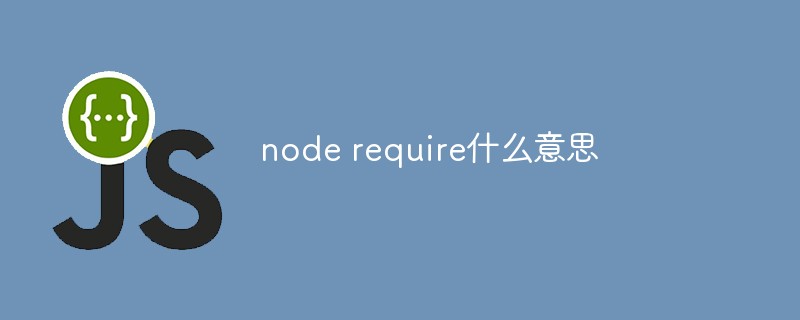node中的require是一个函数,该函数接受一个参数,形参名为id,类型是String;require函数可以导入模块、JSON文件、本地文件;其中模块可以通过一个相对路径从“node_modules”、“本地模块”或“JSON文件”中导出,该路径将针对“__dirname”变量或者当前工作目录。

本教程操作环境:windows7系统、nodejs18.4.0版、Dell G3电脑。
node require什么意思?
Nodejs中的require函数的具体使用方法
说明
本文参考Node官网文档版本为v11.12.0。
本文主要分析了Nodejs中require导入JSON和js文件时得到的结果,同时简单涉及到了Nodejs中模块导出module.exports和exports的用法。
引言
在阅读webpack源码的过程当中,见到如下一行代码:
const version = require("../package.json").version故引申出对Nodejs中require的学习。
require介绍
在Node.js的文档中,require的相关文档是在Modules目录下,属于Nodejs模块化系统的一部分。
require是一个函数。通过typeof或者Object.prototype.toString.call()可以验证这个结论:
console.log(require) // 输出:Function console.log(Object.prototype.toString.call(require) // 输出:[object Function]
通过直接打印require,可以发现在require函数下还挂载着若干个静态属性,这些静态属性也可以在Nodejs的官方文档中直接找到相关的说明:
{ [Function: require]
resolve: { [Function: resolve] paths: [Function: paths] },
main:
Module {
id: '.',
exports: {},
parent: null,
filename: '/Users/bjhl/Documents/webpackSource/index.js',
loaded: false,
children: [],
paths:
[ '/Users/bjhl/Documents/webpackSource/node_modules',
'/Users/bjhl/Documents/node_modules',
'/Users/bjhl/node_modules',
'/Users/node_modules',
'/node_modules' ] },
extensions:
[Object: null prototype] { '.js': [Function], '.json': [Function], '.node': [Function] },
cache:
[Object: null prototype] {
'/Users/bjhl/Documents/webpackSource/index.js':
Module {
id: '.',
exports: {},
parent: null,
filename: '/Users/bjhl/Documents/webpackSource/index.js',
loaded: false,
children: [],
paths: [Array] } } }require函数静态属性
这里之后再详细补充。
require使用
在官网文档中可以看到如下关于require的说明:
require(id)# Added in: v0.1.13 id module name or path Returns: exported module content Used to import modules, JSON, and local files. Modules can be imported from node_modules. Local modules and JSON files can be imported using a relative path (e.g. ./, ./foo, ./bar/baz, ../foo) that will be resolved against the directory named by __dirname (if defined) or the current working directory.
同时还给出了三种require的使用方法:
// Importing a local module: const myLocalModule = require('./path/myLocalModule'); // Importing a JSON file: const jsonData = require('./path/filename.json'); // Importing a module from node_modules or Node.js built-in module: const crypto = require('crypto');
从以上文档中可以得出以下信息:
require接受一个参数,形参名为id,类型是String。
require函数return的是模块到处的内容,类型是任意。
require函数可以导入模块、JSON文件、本地文件。模块可以通过一个相对路径从node_modules、本地模块、JSON文件中导出,该路径将针对__dirname变量(如果已定义)或者当前工作目录。
require实践
在这里将分类讨论require的实践结论。
require导入JSON
JSON 是一种语法,用来序列化对象、数组、数值、字符串、布尔值和 null 。
在文章的开头就提到了通过require("./package.json")文件来读取package.json文件中的version属性。这里将尝试导入info.json文件并查看相关信息。
文件结构目录如下:
. ├── index.js └── info.json
将info.json文件的内容修改为:
{
"name": "myInfo",
"hasFriend": true,
"salary": null,
"version": "v1.0.0",
"author": {
"nickname": "Hello Kitty",
"age": 20,
"friends": [
{
"nickname": "snowy",
"age": 999
}
]
}
}在info.json当中,包含了字符串、布尔值、null、数字、对象和数组。
将index.js的内容修改如下并在当前terminal运行命令 node index.js ,得到如下结果:
const info = require("./info.json")
console.log(Object.prototype.toString.call(info)) // [object Object]
console.log(info.version) // v1.0.0
console.log(info.hasFriend) // true
console.log(info.salary) // null
console.log(info.author.nickname) // Hello Kitty
console.log(info.author.friends) // [ { nickname: 'snowy', age: 999 } ]可以看到,require导入一个JSON文件的时候,返回了一个对象,Nodejs可以直接访问这个对象里的所有属性,包括String、Boolean、Number、Null、Object、Array。个人猜测这里可能用到了类似于JSON.parse()的方法。
通过这个结论也得出了一种思路,即通过require方法传入JSON文件来读取某些值,如在文章开头中,webpack通过读取package.json文件获取到了version值。
require导入本地js文件
文件结构目录如下:
. ├── index.js ├── module_a.js └── module_b.js
index.js文件中,分别按顺序导入了module_a和module_b并赋值,然后将这两个变量打印,内容如下:
console.log("*** index.js开始执行 ***")
const module_a = require("./module_a")
const module_b = require("./module_b")
console.log(module_a, "*** 打印module_a ***")
console.log(module_b, "*** 打印module_b ***")
console.log("*** index.js结束执行 ***")module_a文件中,未指定module.exports或者exports,但是添加了一个异步执行语句setTimeout,内容如下:
console.log("** module_a开始执行 **")
let name = "I'm module_a"
setTimeout(() => {
console.log(name, "** setTimeout打印a的名字 **")
}, 0)
console.log("** module_a结束执行 **")module_b文件中,指定了module.exports(也可以换成exports.name,但是不能直接使用exports等于某个对象,因为exports和module.exports其实是指向了一个地址,引用了相同的对象,如果使用exports等于其他的引用类型,则不再指向module.exports,无法改变module.exports里的内容),内容如下:
console.log("** module_b开始执行 **")
let name = "I'm module_b"
console.log(name, "** 打印b的名字 **")
module.exports = {
name
}
console.log("** module_b结束执行 **")在当前目录terminal下运行 node index.js 运行得到如下输出:
*** index.js开始执行 ***
** module_a开始执行 **
** module_a结束执行 **
** module_b开始执行 **
I am module_b ** 打印b的名字 **
** module_b结束执行 **
{} '*** 打印module_a ***'
{ name: 'I am module_b' } '*** 打印module_b ***'
*** index.js结束执行 ***
I am module_a ** setTimeout打印a的名字 **
通过以上执行结果可以得出结论:
require某个js文件时,如果未通过exports或者module.exports指定导出内容,则require返回的结果是一个空对象;反之可以通过module.export或者给exports属性赋值来导出指定内容。
require某个js文件时,该文件会立即sync执行。
require导入模块
我们先选择一个npm包——cors。 进入文件夹,运行一下命令:
npm init -y // 初始化 echo -e "let cors = require(\"cors\")\nconsole.log(cors)" > index.js // 生成index.js文件 npm install cors --save // 安装cors包
文件结构如下(...处省略了其他的模块):
. ├── index.js ├── node_modules │ ├── cors │ │ ├── CONTRIBUTING.md │ │ ├── HISTORY.md │ │ ├── LICENSE │ │ ├── README.md │ │ ├── lib │ │ │ └── index.js │ │ └── package.json │ │ ... ├── package-lock.json └── package.json
index.js中的内容如下:
let cors = require("cors")
console.log(cors)运行 node index.js ,得出以下结果:
[Function: middlewareWrapper]
找到node_modules下的cors模块文件夹,观察cros模块中的package.json文件,找到main字段: "main": "./lib/index.js" ,找到main字段指向的文件,发现这是一个IIFE,在IIFE中的代码中添加,console.log("hello cors"),模拟代码结构如下:
(function () {
'use strict';
console.log("hello cors"); // 这是手动添加的代码
...
function middlewareWrapper(o) {
...
}
module.exports = middlewareWrapper;
})()再次运行 node index.js ,得出以下结果:
hello cors
[Function: middlewareWrapper]
为什么会打印出 hello cors 呢?因为require模块的时候,引入的是该模块package.json文件中main字段指向的文件。而这个js文件会自动执行,跟require引用本地js文件是相同的。
packjson文档
在npm的官方网站中可以找到关于package.json中的main字段定义。
main The main field is a module ID that is the primary entry point to your program. That is, if your package is named foo, and a user installs it, and then does require("foo"), then your main module's exports object will be returned. This should be a module ID relative to the root of your package folder For most modules, it makes the most sense to have a main script and often not much else.
在以上说明中可以得出以下结论:
main字段是一个模块ID,是程序的主入口。
当使用require("xxx")的时候,导入的是main字段对应的js文件里的module.exports。
所以require导入模块的时候,是运行的对应模块package.json中main字段指定的文件。
推荐学习:《node视频教程》
以上是node require什么意思的详细内容。更多信息请关注PHP中文网其他相关文章!
 CSS:使用ID选择器不好吗?May 13, 2025 am 12:14 AM
CSS:使用ID选择器不好吗?May 13, 2025 am 12:14 AM使用ID选择器在CSS中并非固有地不好,但应谨慎使用。1)ID选择器适用于唯一元素或JavaScript钩子。2)对于一般样式,应使用类选择器,因为它们更灵活和可维护。通过平衡ID和类的使用,可以实现更robust和efficient的CSS架构。
 HTML5:2024年的目标May 13, 2025 am 12:13 AM
HTML5:2024年的目标May 13, 2025 am 12:13 AMhtml5'sgoalsin2024focusonrefinement和optimization,notnewfeatures.1)增强performandemandeffifice throughOptimizedRendering.2)risteccessibilitywithrefinedibilitywithRefineDatientAttributesAndEllements.3)expliencernsandelements.3)explastsecurityConcerns,尤其是withercervion.4)
 HTML5试图改进的主要领域是什么?May 13, 2025 am 12:12 AM
HTML5试图改进的主要领域是什么?May 13, 2025 am 12:12 AMhtml5aimedtotoimprovewebdevelopmentInfourKeyAreas:1)多中心供应,2)语义结构,3)formcapabilities.1)offlineandstorageoptions.1)html5intoryements html5introctosements introdements and toctosements and toctosements,简化了inifyingmediaembedingmediabbeddingingandenhangingusexperience.2)newsements.2)
 CSS ID和类:常见错误May 13, 2025 am 12:11 AM
CSS ID和类:常见错误May 13, 2025 am 12:11 AMIDsshouldbeusedforJavaScripthooks,whileclassesarebetterforstyling.1)Useclassesforstylingtoallowforeasierreuseandavoidspecificityissues.2)UseIDsforJavaScripthookstouniquelyidentifyelements.3)Avoiddeepnestingtokeepselectorssimpleandimproveperformance.4
 课程和ID选择器之间的差异是什么?May 12, 2025 am 12:13 AM
课程和ID选择器之间的差异是什么?May 12, 2025 am 12:13 AMclassSelectorSareVersAtileAndReusable,whileIdSelectorSareEctorSareEniqueAndspecific.1)useclassSelectors(表示)
 CSS IDS vs类:真正的差异May 12, 2025 am 12:10 AM
CSS IDS vs类:真正的差异May 12, 2025 am 12:10 AMIDSareuniqueIdentifiersForsingLelements,而LileclassesstyLemultiplelements.1)useidsforuniquelementsand andjavascripthooks.2)useclassesforporporporblesable,flexiblestylestylestylinglingactossmultiplelements。
 CSS:如果我只使用课程怎么办?May 12, 2025 am 12:09 AM
CSS:如果我只使用课程怎么办?May 12, 2025 am 12:09 AM使用仅类选择器可以提高代码的重用性和可维护性,但需要管理类名和优先级。1.提高重用性和灵活性,2.组合多个类创建复杂样式,3.可能导致冗长类名和优先级问题,4.性能影响微小,5.遵循最佳实践如简洁命名和使用约定。
 CSS中的ID和类选择器:初学者指南May 12, 2025 am 12:06 AM
CSS中的ID和类选择器:初学者指南May 12, 2025 am 12:06 AMID和class选择器在CSS中分别用于唯一和多元素的样式设置。1.ID选择器(#)适用于单一元素,如特定导航菜单。2.Class选择器(.)用于多元素,如统一按钮样式。应谨慎使用ID,避免过度特异性,并优先使用class以提高样式复用性和灵活性。


热AI工具

Undresser.AI Undress
人工智能驱动的应用程序,用于创建逼真的裸体照片

AI Clothes Remover
用于从照片中去除衣服的在线人工智能工具。

Undress AI Tool
免费脱衣服图片

Clothoff.io
AI脱衣机

Video Face Swap
使用我们完全免费的人工智能换脸工具轻松在任何视频中换脸!

热门文章

热工具

ZendStudio 13.5.1 Mac
功能强大的PHP集成开发环境

SecLists
SecLists是最终安全测试人员的伙伴。它是一个包含各种类型列表的集合,这些列表在安全评估过程中经常使用,都在一个地方。SecLists通过方便地提供安全测试人员可能需要的所有列表,帮助提高安全测试的效率和生产力。列表类型包括用户名、密码、URL、模糊测试有效载荷、敏感数据模式、Web shell等等。测试人员只需将此存储库拉到新的测试机上,他就可以访问到所需的每种类型的列表。

Dreamweaver Mac版
视觉化网页开发工具

Dreamweaver CS6
视觉化网页开发工具

SublimeText3汉化版
中文版,非常好用





